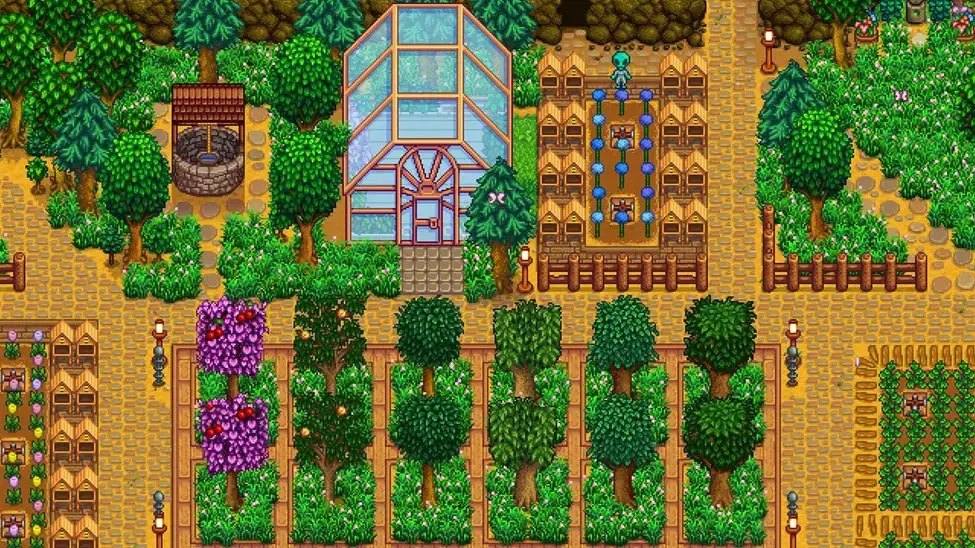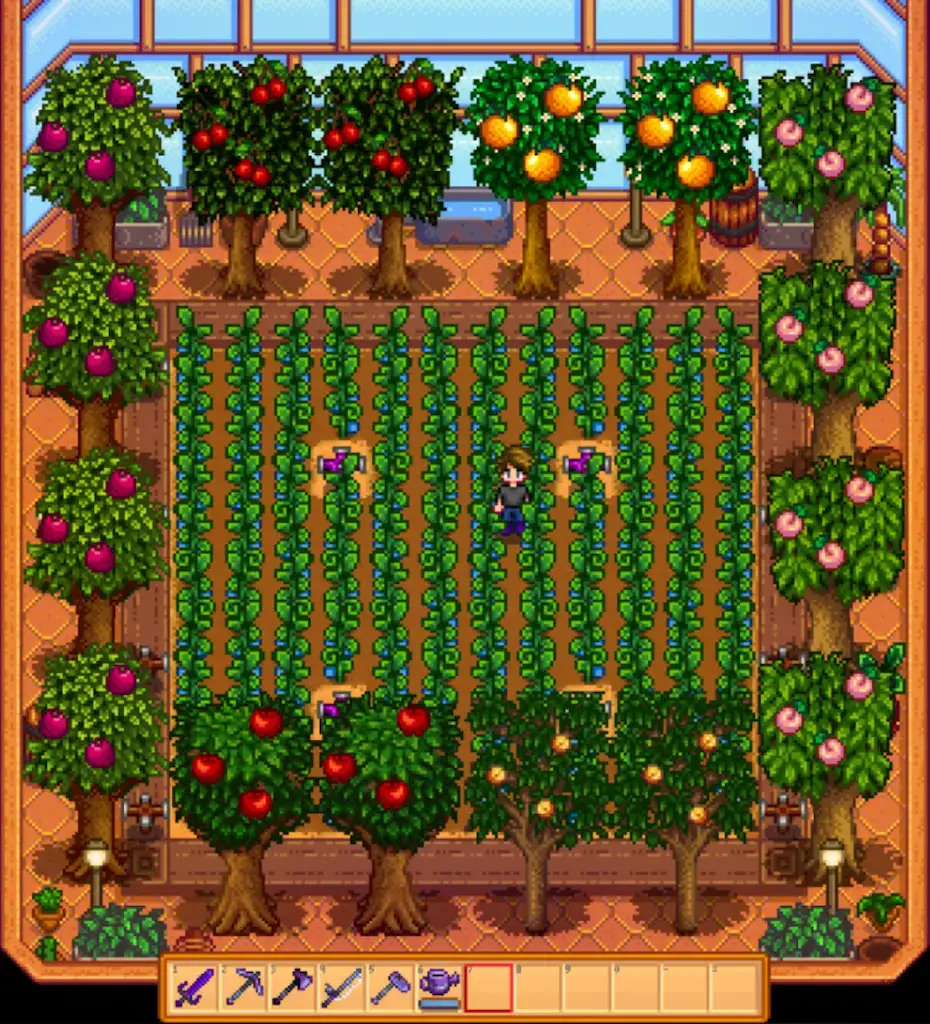Mastering Fruit Tree Spacing in Stardew Valley
Fruit trees are an integral part of Stardew Valley, adding a new kind of “crop” you can grow on your farm. Growing fruit trees differs slightly from growing other kinds of crops as it requires some highly specific spacing to allow your trees to mature properly. This means that if your fruit trees are not spaced apart correctly, while they would get planted, they would never fully mature.
As the game does not have the same spacing requirements with non-fruit trees such as Maple, Oak, Pine, or Mahogany, it can lead to some confusion when it comes to planting fruit trees. Many players who aim to have fruit orchards are flummoxed when their orchards show no progress, which is why this article can help you build up the perfect fruit orchard. As fruit tree saplings are a hefty investment, getting the spacing of them correct on the first try is vital to maximizing your total output from them. This is because fruit trees are not simple to relocate, and need to be chopped down and then replanted, making this a highly time-consuming mistake.

Clear Ground Area Requirements
All fruit trees have the same spacing and growth requirements. The spacing requires that the surrounding 8 tiles around the tree be completely free from all obstructions and objects. This means that there should be no objects, terrain features such as grass, tilled soil, or other types of flooring next to the fruit tree sapling while it matures.
An important point to remember is that this spacing rule applies to fruit trees only when it is maturing. Once it is fully mature, which takes 28 in-game days, ground level obstructions have no effect on the tree anymore. However, this does not mean other fruit trees, and the same level of space is required from the base of each fruit tree.
In addition, once fruit trees are fully mature, non-fruit trees, such as the ones mentioned above, can be planted 2 tiles away from fully mature fruit trees, without stinting the growth of either plant.
What is the best season to plant your fruit trees in?
Fruit trees take 28 in-game days to mature and start producing fruit. The following passage outlines which fruit trees mature in which season.
Spring
Apricot and Cherry trees grow fruit in Spring time, and their sapling prices range from 1500g — 2500g, and 2550g — 4250g respectively, making them an expensive investment. These should ideally be planted on Winter Day 1 to maximize their yield during Spring.
Summer
Update 1.5 of Stardew Valley saw the addition of Banana and Mango trees- both of which can only be acquired through Island Traders for Dragon Teeth and Mussels respectively.
Other Summer fruit trees include Orange (priced at 3000g — 5000g) and Peach saplings (priced at 4500g — 7500g).
All Summer Fruit tree saplings should be planted on Spring Day 1 to maximize their yield during Summer.
Fall
Fall fruit tree saplings include Pomegranate, which can be bought for 4500g — 7500g, and Apple which can be bought for 3000g — 5000g. These should ideally be planted on Summer Day 1 to maximize their output.
Winter
There are no fruit trees that flower during Winter time.
To circumvent the changes of weather, players prefer to plant their fruit trees in either their Greenhouse, or Ginger Island, both of which don’t experience changes of the season, allowing you to be able to harvest fruit from them year-round.
Specific Spacing Requirements
Each fruit tree requires a 3 by 3 clear space, which means that the center tile on which the fruit tree sapling is planted should have 8 clear tiles next to them.
Do different types of fruit trees have different spacing requirements?
The short answer is: No. While there may be a large variety in the types of available fruit trees, the spacing requirements remain exactly the same regardless of the type of fruit tree you are planting.
Optimizing your Fruit Tree Placement
Different fruit trees mature in different seasons, taking 28 in-game days to grow. And while it may be tempting to chop down your fruit trees after their yielding season has passed, keep in mind that the more years you keep your fruit trees, the higher the quality of fruit that they yield. This means that fruit trees will produce silver star fruit after the first year, gold star fruit after the second, and iridium star fruit after the third.
If you are a Tiller by Profession, you will also receive a price bonus when you sell any of your fruit. Each tree will yield one fruit per in-game day, and if you choose to not get fruit from your tree daily, you can get three fruits on Day 3.
Exceptions and Special Considerations
Another point to remember is that the spacing rule varies slightly when it comes to permanent structures. Here, permanent structure refers to houses or greenhouses. This means that if you want to start an orchard in your greenhouse, you will only need to maintain 2 tiles of space from the wall of the greenhouse, while maintaining 3 tiles of space from other objects or fruit trees.

Visual Demonstrations and Video Tutorials
Spacing out your fruit trees is a hot topic of discussion across many Stardew Valley forums. This thread on Reddit goes into some detail about this topic while this thread contains a visual representation of what not to do when it comes to planting your fruit trees.
Additionally, you can go in to the options of the game, where you can mark a checkbox that shows you the correct item placement. Checking this item will turn the area you are planning to plant your tree as either red or green, making it an excellent visual guide to help you plant your fruit tree saplings.
Conclusion
Spacing out your fruit trees incorrectly can result in a lot of losses as it stops your fruit trees from fully maturing which can significantly decrease your fruit yields. For this reason, it is vital to get your spacing correct the first time around and hopefully, this guide will help you build up the perfect orchard!